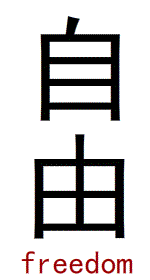Lesson 12 Self, Freedom 自由
Lesson 12 Self, Freedom 自由
We have learned two symbols 目 (eye) and 日 (sun) in previous lesson. Now we are going to add one extra stroke to create another symbols.
Here is the 自, the symbol for Self, it’s the symbol 目 (eye) with a very short slanted stroke / on the top.
自
self, since
pronunciation: Zì
In the animation, there are two parts of this symbol 自, the red color is just a short slanted stroke, and the blue color is the strokes for another symbol 目 (eye) which is in Lesson 11.
This 自 symbol means Self, acts with another noun or verb as an adjective or adverb. It also means From, Come From, Since, as an adverb, like 自古, since ancient times,
自古(since ancient times) = 自(since) + 古(ancient)
Please check the symbol 古(ancient) in Lesson 05.
Here is another 2-character phrases: 自右 (from right), 自左 (from left)
自右(from right) = 自(from) + 右(right)
自左 (from left) = 自(from) + 左(left)
Please check Lesson 10 for the symbols 右(right) and 左(left).
The next symbol we have here is 由, it’s the symbol 日(sun) with a vertical bar 丨 standing erect at the center.
由
from, cause
pronunciation: Yóu
In this animation of 由 symbol, I also use two colors to decompose this character. The first (red) strokes part is drawing a ㄇ shape, and the second (blue) strokes part is drawing the symbol 土 with a longer neck. Please don’t worry about the order of those strokes, it’s the regular way in calligraphy writing and you just take a look and try not to be hypnotized.
The 由 symbol also has rich meanings, like From as the 自 symbol. It can be used as a noun as Cause, Reason, or By, Through as an adverb, or Follow, Allow as a verb.
However we don’t like to learn each Chinese character in this kind of confusing way, let’s just find some example, even though we have learned only few characters so far.
How about 自由?
The two symbol we have just learned.
自(self, since) + 由 (from, cause) = ?
自由 is FREEDOM!
Can you figure it out yourself?
自(self, since) + 由 (from, cause) = 自由 = FREEDOM?
by the cause of oneself?
This 自由(free, freedom) is a modern word, which might be translated from Japanese kanji in early 1900s, and the Japanese created it during the Meiji Restoration in 19th century while importing lots of Western cultures.
Here is the 3-character word: 自由人, freeman
自由人(freeman) = 自由(freedom) + 人(human, people)
自由
freedom
pronunciation: zì yóu
The animation is displaying different calligraphic styles for 自由(freedom) written vertically. The traditional Chinese calligraphy write characters vertically from top to bottom, column by column aligned from right to left.
I think I’d better to slow down the pace, introduce 1-2 new symbols each time in one lesson. We will learn about 300-500 Chinese characters in one year if I keep writing this blog continuously. With the vocabulary of 300-500 Chinese characters, you could even understand another 300-1000 similar characters of your own! See, you will be able to write and read Chinese in just one year!
Thanks for your reading and practicing, any positive feedback is welcome.
Review and further study
自
self, since
pronunciation: Zì
with pronunciation play button, calligraphic strokes animation, different calligraphic styles, related Chinese words, and more…
自古
since ancient times
pronunciation: zì gǔ
自右
from right
pronunciation: zì yòu
自左
from left
pronunciation: zì zuǒ
由
from, cause
pronunciation: Yóu
with pronunciation play button, calligraphic strokes animation, different calligraphic styles, related Chinese words, and more…
自由
freedom
pronunciation: zì yóu
with pronunciation play button, related Chinese words, and more…
自由人
freeman
pronunciation: zì yóu rén




Comments
Post a Comment